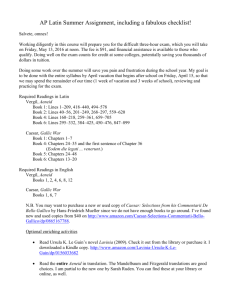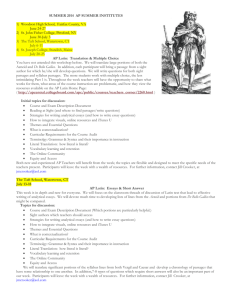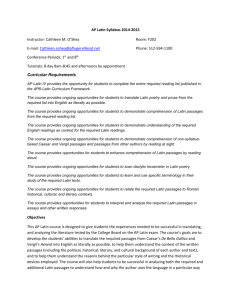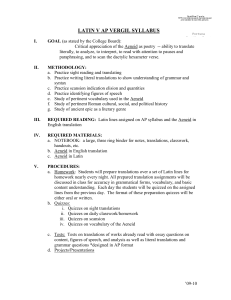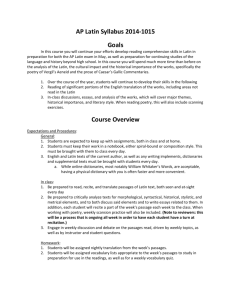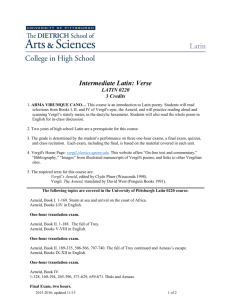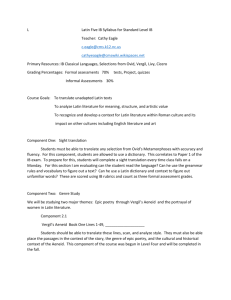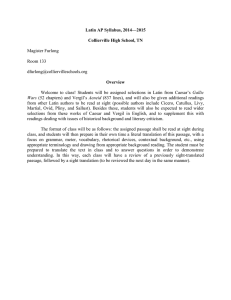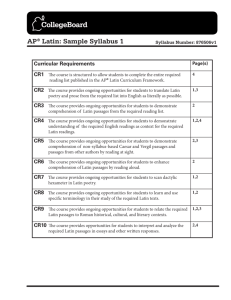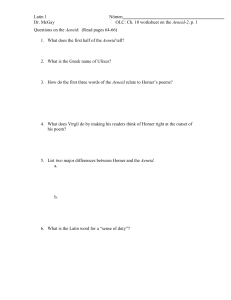AP Latin
advertisement
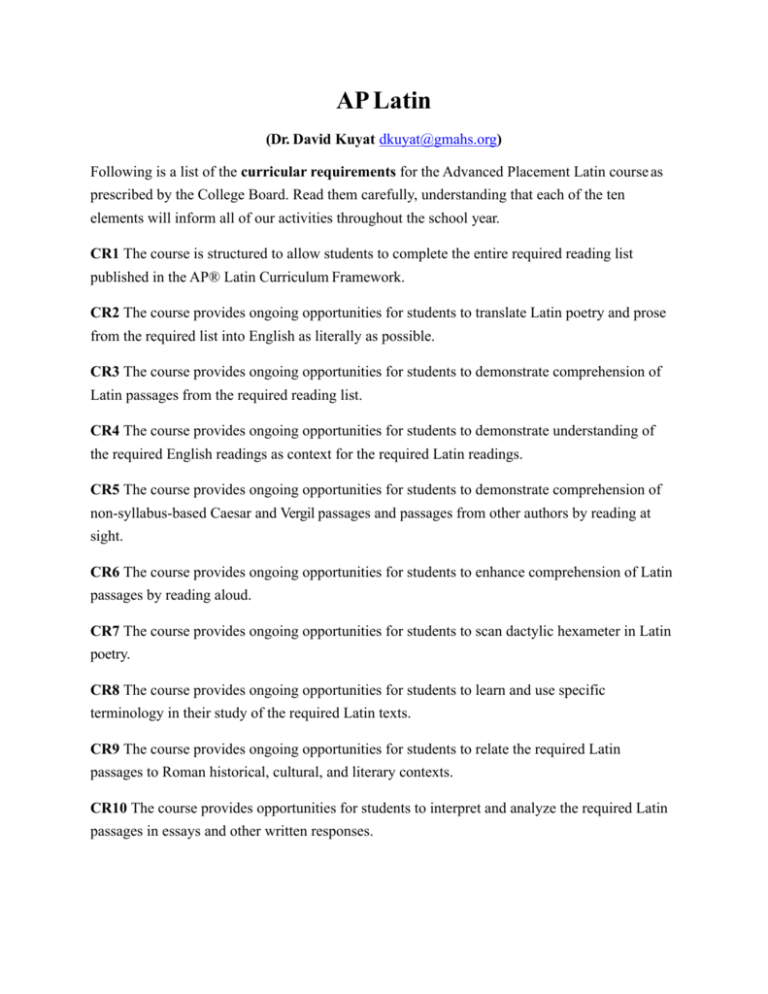
AP Latin (Dr. David Kuyat dkuyat@gmahs.org) Following is a list of the curricular requirements for the Advanced Placement Latin course as prescribed by the College Board. Read them carefully, understanding that each of the ten elements will inform all of our activities throughout the school year. CR1 The course is structured to allow students to complete the entire required reading list published in the AP® Latin Curriculum Framework. CR2 The course provides ongoing opportunities for students to translate Latin poetry and prose from the required list into English as literally as possible. CR3 The course provides ongoing opportunities for students to demonstrate comprehension of Latin passages from the required reading list. CR4 The course provides ongoing opportunities for students to demonstrate understanding of the required English readings as context for the required Latin readings. CR5 The course provides ongoing opportunities for students to demonstrate comprehension of non-syllabus-based Caesar and Vergil passages and passages from other authors by reading at sight. CR6 The course provides ongoing opportunities for students to enhance comprehension of Latin passages by reading aloud. CR7 The course provides ongoing opportunities for students to scan dactylic hexameter in Latin poetry. CR8 The course provides ongoing opportunities for students to learn and use specific terminology in their study of the required Latin texts. CR9 The course provides ongoing opportunities for students to relate the required Latin passages to Roman historical, cultural, and literary contexts. CR10 The course provides opportunities for students to interpret and analyze the required Latin passages in essays and other written responses. Objectives This course is designed to prepare students for a successful performance on the College Board AP Latin exam. Each assignment and assessment, both those completed outside and within the classroom, is intended to develop the students’ abilities to translate the required passages (cited below) into English as literally as possible, to help them understand the context of the passages (political, historical, literary, and cultural), and to help them recognize the individual style of each author as well as understand his employment of rhetorical devices. Students will learn to analyze the authors’ diction and the effect it intends to produce. They will also become practiced in reading Latin prose and poetry aloud with accurate pronunciation and attention to morphology and meter. Additionally, we will sharpen these skills (as well as enrich the student’s experience) by working regularly with sight-based passages from beyond the required texts. Each one of these skills will be practiced on a daily or weekly basis. Course Primary and Secondary Texts The AP course calls for the study of selections from two primary texts, Julius Caesar’s De Bello Gallico and Vergil’s masterpiece, the Aeneid. The course will also require students to read the English translations of the works in their entirety. The following list includes these texts in the original language, as well as translations and workbooks which will assist greatly in the comprehension of the Latin literature. There will be additional English articles and noncurriculum Latin texts provided by the teacher throughout the course. 1. Mueller, Hans-Friedrich. Caesar: Selections from De Bello Gallico. Bolchazy- Carducci Publishers, 2012. 2. Williams, Rose and Debra L.Nousek. A Caesar Workbook. Bolchazy-Carducci Publishers, 2012. 3. Boyd, Barbara Weiden. Aeneid: Selected Readings from Books 1, 2, 4 and 6. Bolchazy-Carducci Publishers, 2012. 4. Bradley, Katherine, and Barbara Weiden Boyd. A Vergil Workbook.Bolchazy-Carducci Publishers, 2nd ed., 2012. Of the original texts, these are the lines which are required for successful completion of the course and successful preparation for the AP exam: Caesar, De bello Gallico Book 1: Chapters 1-7 Book 4: Chapters 24-35 and the first sentence of Chapter 36 Book 5: Chapters 24-48 Book 6: Chapters 13-20 Vergil, Aeneid Book 1: Lines 1-209, 418-440, 494-578 Book 2: Lines 40-56, 201-249, 268-297, 559-620 Book 4: Lines 160-218, 259-361, 659-705 Book 6: Lines 295-332, 384-425, 450-476, 847-899 Course Overview The first semester (quarters 1 and 2) will be dedicated to the study of Vergil’s Aeneid, and the second semester will be devoted to Caesar’s De Bello Gallico. At the beginning of each semester, within the first two weeks, students will be required to read the respective translation of the work. This will provide the basis for an ongoing discussion of the greater context into which the selected Latin passages are woven. The pace of reading in the course is rigorous, and so students will be expected to keep up with their daily assignments. They are to translate the assigned Latin texts literally and to continually demonstrate their comprehension of the vocabulary, grammar, syntax, and context of the passage. Helpful notes and commentary will be available to them from the required text list, as well as additionally from the teacher. Following is a general breakdown of the day-to-day work by which we will meet the curricular standards of preparation as stated above by the College Board: 1) Daily Literal Translation. Students are required to keep a notebook in which they must stay up to date with the daily literal translations including the homework readings. Students must always bring their texts and appropriate writing tools to the classroom. At this time, students will also read selections aloud in the original language with a mind to pronunciation, intonation, inflection, and meter. As we discuss these prepared translations, student will be required to consistently use specific terminology to refer to grammar and literary devices. They will also be asked to demonstrate comprehension by discussing and answering questions (both oral and written) about passage content, vocabulary, literary techniques, and grammar. Finally, the course will frequently include non-syllabus passages to be translated at sight. These will be accompanied by short answer questions and/or multiplechoice, so as to prepare the students for the corresponding section of the AP exam. 2) Quizzes will include short translations and relevant vocabulary. 3) Tests will include a long, passage-based essay in which the student must analytically and appropriately connect evidence from the Latin passage to a discussion of the its social or political relevance, major themes, etc. Furthermore, short answers and multiple-choice questions based upon sight-readings will be included. Sight-readings will be drawn from a variety of prose and poetry authors from beyond the syllabus, such as Cicero, Catullus, Ovid, Martial, Sallust, and Pliny. Grading Classwork- one point will be assessed for all in-class work including participation in individual and group work. Homework- two points will be assessed for all homework assignment. All assignments will be made available prior to class on backpack Quizzes- Approximately six 10 point quizzes will be administered during the quarter. Quizzes will be assigned online a week before being administered. Tests- Approximately two 50 point tests will be administered during the quarter. These will include at least two essays in which students must interpret and analyze passages based on the question and provide textual evidence to support their opinions; literal translations of passages; short answers on stylistic uses within the text and on the required English readings; scansion of 5-6 lines; multiple choice items will cover relevant content, vocabulary, literary style, and grammar on sight passages. Course Schedule First Quarter 1. a. Complete Aeneid in translation (Chapters 7-12) and discuss as contextual background throughout the Latin readings. b. Read Aeneid Book 1: 1-60 2. Read Aeneid Book 1: 61-120 3. Read Aeneid Book 1: 121-181 4. Read Aeneid Book 1: 182-209, 418-440 5. Read Aeneid Book 1: 494-578 6. Test on Aeneid Book 1 a. Discuss background information on Book 2 b. Read Aeneid Book 2: 40-56, 201-249 7. Read Aeneid Book 2: 268-297, 559-589 8. Read Aeneid Book 2: 590-620 9. Test on Aeneid Book 2 Second Quarter 1. a. Discuss background information on Book 4 b. Read Aeneid Book 4: 160-218 2. Read Aeneid Book 4: 259-309 3. Read Aeneid Book 4: 310-361 4. a. Read Aeneid Book 4: 659-705 b. Test on Aeneid Book 4 c. Discuss background information on Book 6 5. Read Aeneid Book 6: 295-332, 384-404 6. Read Aeneid Book 6: 405-425, 450-476 7. a. Read Aeneid Book 6: 847-899 b. Test on Aeneid 6 Third Quarter 1. a. Read De bello Gallico in translation, Books 1-7 b. Discuss important background information on Caesar and the Gallic Wars c. Read De bello Gallico Book 1: Chapter 1 2. Read De bello Gallico Book 1: Chapters 2-3 3. Read De bello Gallico Book 1: Chapters 4-5 4. a. Read De bello Gallico Book 1: Chapters 6-7 b. Review Book 1 c. Test Book 1 5. Read De bello Gallico Book Book 4: Chapters 24-26 6. Read De bello Gallico Book Book 4: Chapters 27-30 7. Read De bello Gallico Book Book 4: Chapters 31-34 8. Read De bello Gallico Book Book 4: Chapter 35 and the first sentence of Chapter 36 (Eodem die legati . . . venerunt.) 9. Test Book 4 Fourth Quarter 1. Read De bello Gallico Book 5: Chapters 24-29 2. Read De bello Gallico Book 5: Chapters 30-35 3. Read De bello Gallico Book 5: Chapters 36-41 4. a. Read De bello Gallico Book 5: Chapters 42-48 b. Test on Book 5 5. Read De bello Gallico Book 6: Chapters 13-15 6. Read De bello Gallico Book 6: Chapters 16-18 7. a. Read De bello Gallico Book 6: Chapters 19-20 b. Test on Book 6 8. Review and Take Practice AP Exams
